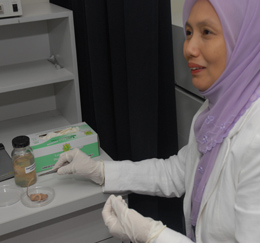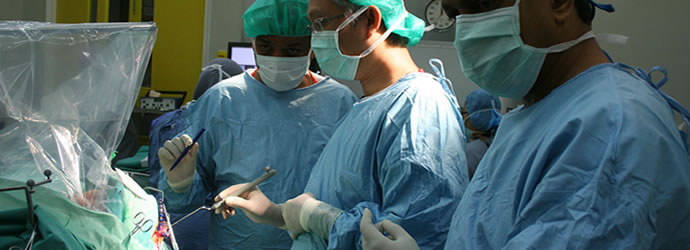By Shahfizal Musa
Pix Izwan Azman
KUALA LUMPUR 22 July 2013 – The National University of Malaysia Medical Centre is the first Hospital in Asia to use the latest technique in thyroid surgery which drastically reduces risk of injury to vocal cords .
With the aid of Automated Periodic Stimulation (APS) combined with existing Nerve Integrity Monitoring system, the risk of injury to vocal cords in thyroid surgery can be reduced by 95 percent, said Prof Dr Rohaizak Muhammad an Endocrine and Breast Surgeon in UKMMC who pioneered this nerve monitoring method for thyroid surgery in UKM and Malaysia.
The technique which is a surgical landmark in thyroid surgery is only practiced in Europe and the United State of America at this moment.
Thyroid surgery is done to remove the thyroid gland located in the neck. The thyroid gland produces hormones that act throughout the body, influencing metabolism, growth and development, and body temperature.
Thyroid surgery or thyroidectomy is needed to treat thyroid thyroid cancer, nodules, and hyperthyroidism. During these procedures, part or all of the thyroid gland is removed. But there are risks of injuring the recurrent laryngeal nerve (RLN), which is connected to the vocal cord. This can result in patients left with a husky voice or losing it totally.
The RLN is like the power cable that connects your house to the electric grid. Similarly the RLN is the cable that makes your larynx and few other muscles in your throat function. Basically it controls the sensation and movement of your voice box.
Located behind the thyroid glands, surgeons have a hard time, keeping track of it, especially when removing the thyroid gland.
With APS system this can be avoided. It is just like the parking sensor at the back of your car, it starts by giving a beeping sound when there is an obstacle close by.
By using this nerve monitoring system in a thyroid surgery, it operates very much the same way. Every time surgical dissection gets a little too close to the RLN a beeping sound would go off.
How this is accomplished is by attaching an electrode to the vagus nerve. The other end of the electrode goes to the monitor. The electrode inserted in the throat, touching the vocal cord, is periodically stimulated. This will alert the surgeon if he is too close for comfort to the RLN and might unintentionally harm it. This gives him ample warning to reassess how he wants to maneuver the dissection.
Dr Rohaizak, said based on statistic 3 out of 100 patients who undergo thyroid surgery face risk of getting their RLN injured.
He jokingly said after performing such surgery that this actually proves the existence of God. The RLN has a different position than other nerves, this fact has been used by people to argue that humans were created by God.
“The reason why a surgery is successful before the use of this system is not because the surgeon is great but it is God that protects the patients RLN from human error,” he said.
Risk of Thyroid surgery
Having a husky voice may not be a big deal to many but it can create problems when your voice is the bread winner.
Imagine if you work as teacher, lecturer, or singer; it can mean the end of your career.
A lot of people are reluctant to undergo thyroid surgery because after the surgery they may end up with a different problem.
Imagine coming out the operating theater with a different voice or no voice at all.
In some cases the patient would need a tracheostomy where a hole had to be drilled on the throat to facilitate breathing.
Because of the damage to the RLN the vocal cord loses its ability to automatically shut.
So when you eat the food would fall into your air valve causing you to choke.
These are the risks of thyroid surgery in extreme cases. With the aid of APS in thyroid surgery all these can be avoided.


Creative Surgery
The beauty of this technique is that, it does not require major investment on the part of the hospital to buy new equipment. The equipment needed is already available in most hospitals. It is used in other nerve surgery like spinal surgery and parotid surgery.
But it only requires minor adjustment to the setting of the machine. Then it will become a revolutionary safety instruments for patients in a thyroid surgery.
It does however need an electrode which is connected to the vagus nerve in the neck.
The RLN is a branch of the vagus nerve and once the electrode is connected, the screen will display the safe range for surgeons to operate.
The surgeon then would perform the gland extraction guided by the monitor and the beeping alarm sound. It helps the surgeon in doing his work, because he does not have to stop and identify the location of the RLN every minute.
He can focus on removing the gland without worrying he might cut the RLN. As the equipment is readily available, there is no extra cost needed.
But Dr Rohaizak believes if the surgery is implemented as a teaching program in UKM he is confident that he can discuss with the suppliers to bring the cost further down.
This new procedure is a great improvement in terms of safety to the patients. It does not require any investment so any major hospital can do it.
He is even willing to set up a training program. He does not know how hospitals in the country will respond to this new method. What is for sure, he had already received requests from surgeons from other parts of Malaysia to learn about the technique. Next is to have training workshop in the neighbouring countries.







